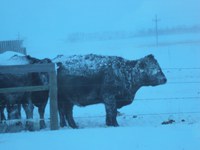Record Cattle Death Losses for Livestock Indemnity Program
(Click the image below to view a high-resolution image that can be downloaded)
North Dakota cattle producers need to record deaths in their cow herds because those records may help them recover part of the cost of those losses through the Livestock Indemnity Program (LIP), North Dakota State University Extension specialists say.
The LIP provides benefits to eligible livestock owners or contract growers for livestock deaths in excess of normal mortality resulting from conditions such as adverse weather, diseases and predator attacks.
However, the occurrence of an eligible loss condition does not automatically trigger benefit payments. The livestock owner or contract grower must provide evidence of that eligible loss, according to the U.S. Department of Agriculture’s Farm Service Agency, which administers the LIP.
“Transient weather changes usually are endured by well-fed livestock,” says Karl Hoppe, Extension livestock systems specialist at the Carrington Research Extension Center. “Cattle seem to handle two or three days of subzero weather without issues. However, extended cold weather can challenge livestock.”
Extreme cold weather is hitting North Dakota cow herds hard this year. The North Dakota Agricultural Weather Network (NDAWN) reported that from Jan. 1 to Feb. 10, Carrington, N.D., had a one-day low temperature of minus 40 F and six days with low temperatures of minus 20 F or lower.
“While actual temperatures have been brutal, cattle usually aren’t housed in barns, and the wind chill is a better identifier of cold stress,” says John Dhuyvetter, Extension livestock systems specialist at the North Central Research Extension Center near Minot, N.D.
The NDAWN weather station at Carrington recorded five days of wind chills of minus 40 or lower and 25 days of wind chills of minus 20 or lower between Jan. 1 and Feb. 10.
Windbreaks made of trees, barns, round hay bales and wooden or metal fences help reduce the effects of wind. Because the prevailing winds in North Dakota are from the northwest, most windbreaks are placed to provide relief from winds from that direction. Those windbreaks don’t provide wind-chill relief from winds from the south, east or southeast.
“Creating more windbreak is the solution, but that also may trap more snow,” Hoppe notes.
Dhuyvetter says bedding can provide some relief from cold, and cows will seek bedded areas that aren’t snow-laden.
Frozen waterers also can be a problem in cold weather. When waterers are frozen, cattle won't eat feed or will reduce their feed intake, Hoppe says.
Cattle require enough feed during the winter to meet their energy needs. A rule of thumb for feeding cattle in cold weather is to increase the feed energy (total digestible nutrients) provided by 1 percent for every degree of temperature drop below the cow’s thermal neutral zone. For cows with a full winter hair coat, the lower critical temperature is an estimated 15 F.
“Death losses may occur despite extra efforts to feed, bed and create more shelter,” says Bryon Parman, Extension agricultural finance specialist. “If death losses do occur, be sure to record the date, take a picture as proof and report the loss to the USDA Farm Service Agency for the Livestock Indemnity Program.”
He adds: “Death losses above the expected yearly average can put significant financial strain on livestock producers. While the loss of a calf might cost a producer around $825 in lost revenue, the loss of an adult pregnant cow could exceed $2,000 each.
“Producers who do not take advantage of the program are then put at a disadvantage against those who do,” he says. “Furthermore, weather affects each operation differently, and the LIP helps ensure producers remain competitive and able to continue operating though tough conditions.”
Visit https://tinyurl.com/LivestockIndemnity-2018 for more information about the LIP program.
NDSU Agriculture Communication - Feb. 14, 2019
| Source: | Karl Hoppe, 701-652-2951, karl.hoppe@ndsu.edu |
|---|---|
| Source: | John Dhuyvetter, 701-857-7682, john.dhuyvetter@ndsu.edu |
| Source: | Bryon Parman, 701-231-8248, bryon.parman@ndsu.edu |
| Editor: | Ellen Crawford, 701-231-5391, ellen.crawford@ndsu.edu |


